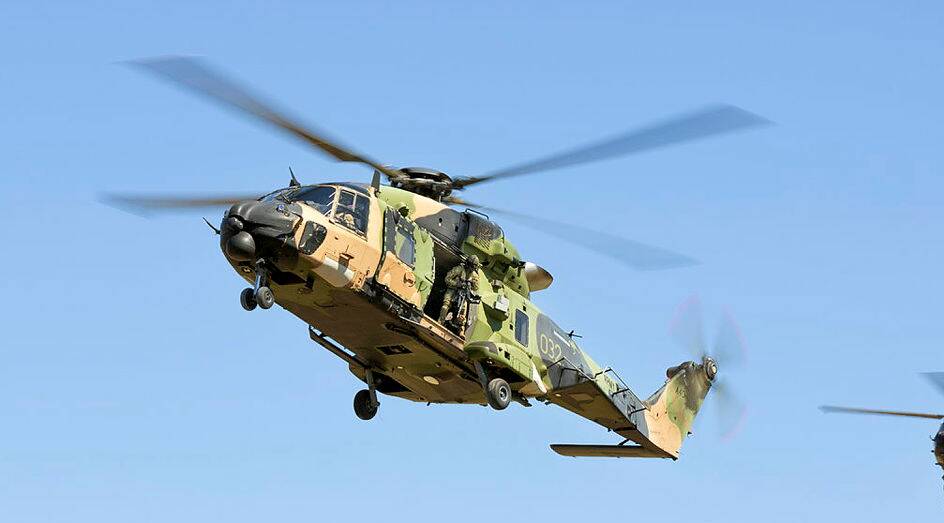What are they hiding?
Something stinks in this business of harvesting parts from the army's decommissioned Taipan helicopters and burying the stripped carcasses. And there's been an odour hanging about the service's management of the aircraft for years.
We need to know what's really been going on.
The former government decided in 2021 to retire the Taipans more than a decade early because of the cost and difficulty of operating them. We're spending $3 billion to buy 40 helicopters of the latest version of the elderly model that the Taipan replaced, the Blackhawk.
After a Taipan crashed near Lindeman Island in July, the survivors were grounded. By September, the government had decided never to fly them again, even though the cause of the fatal accident reportedly turns out to be error in operation, not a mechanical fault.
Ukraine then asked for them as donation, but the Department of Defence has instead arranged for them to be stripped and buried, something we know only because Asia-Pacific Defence Reporter broke the story last month.
So the defence establishment's avoidance of accountability has got to the stage where it can dispose of something like $1 billion of public assets without even bothering to tell the public.
Let's go back to the beginning. The Taipan is an Australian version of the NH90, which is made by a consortium of European companies led by Airbus. It's basically a transport aircraft, used for such tasks as shifting soldiers to and from a battlefield and carrying supplies.
As part of a program that commendably aimed at simplifying our chopper fleet, it was chosen in 2005 to replace the Blackhawk in army service and the Sea King for the navy. We ultimately bought 47 Taipans and told the navy, which needed six, just to draw its share from the army-managed pool without modifications.

But Airbus and its partners hadn't completed development of the NH90 when we ordered, so when Taipans arrived we found that they had plenty of faults.
That established the Australian reputation of the type as a dud. And even as many faults were fixed, the cost per flying hour remained ridiculously high and reliability low. Hence the 2021 move to promptly go back to the Sikorsky Blackhawk for the army. The navy will be getting 12 costly Sikorsky Seahawks, whose design is based on the Blackhawk, partly to replace its share of the Taipan fleet.
But here's the thing: not all NH90 operators have had as much trouble as we have. On average, the NH90 does look like a poor performer, and some other users have wanted to get rid of it, but yet others seem to be getting along with it not too badly.
Most embarrassingly for the Australian Army, the Royal New Zealand Air Force is getting 75 per cent availability from NH90s, almost reaching its target, even though it has the challenge of running a small fleet of eight.
The incuriosity of a succession of Australian defence ministers about this state of affairs tells us a lot about the ineffective political oversight of our defence establishment.
Anyway, we need to find out why the Australian Army has had a worse NH90 experience than others. An inquiry into whether and how it has mismanaged Taipan operation would pay valuable returns.
Defence Minister Richard Marles should establish the inquiry with unbiased experts. Good choices would be a retired officer from the British Army, which has neither NH90s nor Blackhawks, and a retired executive from a helicopter maker other than Airbus and Sikorsky.
They can quiz other NH90 operators, such as reasonably happy New Zealand and not-at-all-happy Norway, put hard questions to Airbus, and work out why Australia has done so badly in this business.
Don't for a moment expect the army to simply fess up.
MORE AGE OF THE DRAGON:
Credit goes to APDR journalist Kym Bergmann for dogged coverage of this affair. And it was Bergmann who last month broke the story that the Taipans were being taken to pieces.
Ukraine is desperate for whatever equipment it can get, including battlefield helicopters. It has far bigger problems to worry about than high costs per flight hour, and in any case could keep a substantial ex-Australian fleet going with help from nearby NH90 operators in Europe.
Notice that other countries are donating even F-16 fighters to Ukraine.
Defeat of Russia in the Ukrainian war is deeply in our interest. The last thing we want China to see is that aggression pays.
So why on earth have we we refused to load the Taipans onto C-17 airlifters and rush them to Ukraine? Don't tell me it's because the manufacturer offered us a few tens of millions of dollars for parts. We'll spend some of that decontaminating the airframes before burial, anyway.
And why has the department tried to keep all this a secret? No conceivable matter of national security justifies confidentiality here.
There must be something going on. I hope it's not that the army wants to avoid us seeing another armed service not only successfully using Taipans but even fighting a war with them. The government obviously won't let an inquiry examine perverse actions on its own watch, so the responsibility for looking into this falls to the opposition and the media.
I encourage journalist colleagues in any media outlet to take an interest. And they should start by adopting a more sophisticated view of the situation than "Australia buries dud choppers."
The department did not immediately reply to my questions on this.
One more thing. We must cancel the dismantle-and-bury operation, reassemble the Taipans and send them with our stock of spares and support equipment to Ukraine as soon as possible.
- Bradley Perrett was based in Beijing as a journalist from 2004 to 2020.


